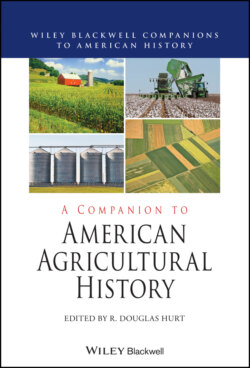Читать книгу A Companion to American Agricultural History - Группа авторов - Страница 28
The Westward Movement
ОглавлениеA tidal wave of Europeans moved across the Appalachian Mountains into the lands once owned by Native American tribes. In 1795, 150,000 people were west of the mountains; by 1810, one million. Between 1790 and 1830, Kentucky grew from 74,000 people to 688,000; Ohio from 45,000 to 938,000; Tennessee from 36,000 to 682,000; and Alabama from 1000 to 310,000 (US Bureau of the Census 1975; Rohrbough 2008).
Three sources accounted for this surge in western numbers. The first was the state of Virginia. Virginia expelled farmers by practices that created soil infertility, by land monopoly, and by the desires of elite youth to have their own plantations. Between 1790 and 1860, one million Virginians forsook the state; they swarmed into Kentucky and Tennessee and later into the southern portions of Ohio, Indiana, Illinois, and Missouri. One offshoot turned south and went to Mississippi and Alabama (Fischer and Kelly 2000). A second flow into the southwest came from Georgia and South Carolina due to the cotton boom and soil exhaustion (Meinig 1993; Rohrbough 2008).
The second and third sources of migrants came from New England and Pennsylvania. The Pennsylvania (and partially New York) migration streamed into the middle parts of Ohio, Indiana, and Illinois (Meinig 1993). Researchers have bestowed much attention upon the New Englanders who entered western New York and, after 1815, went into the northern parts of Ohio, Indiana, and Illinois. This particular migration arose because the eastern Massachusetts farm had shrunk to less than 60 acres, barely able to sustain a family (Meinig 1993; Johnson 2007).
The area west of the Appalachian Mountains, after the Native Americans were eliminated, was the empire of the pioneer. Everywhere the general pattern of pioneering was the same. Small farmers dominated the initial movement and confronted an impenetrable forest. Pioneers spent years cutting down trees, making fences, clearing land, and building log cabins and other structures; maize was the universal crop and hogs the universal animal. Even after 30 or more years, the pioneer farm was crude (Rohrbough 2008; Williams 1989). Southerners had a different pattern than northerners. Yeoman farmers were the initial wave of migrants to the West, but as soon as they created a stable political framework, planters entered with their slaves. Slaves were efficient and effective in clearing the land and building cabins; they quickly began cotton cultivation (Billington 1974; Foust 1975).
By 1830, Ohio, Kentucky, and Tennessee had passed out of the frontier stage but the other areas had not. The land remained immensely forested, most agriculture was subsistence, farmers spent time hunting, and women engaged in cooking, clothes-making, child-raising, and home manufacturing. Most market activity was local and extensive trade only occurred if the farmer resided near the Ohio–Mississippi River system. The nature of the pioneer experience was arduous, isolated, and monotonous (Cashin 1991; Rohrbough 2008).
